List of Authors
>>About this blog
Recent blog post
|
[Ryokichi]
January 28, 2014 14:00
I'm sorry that it was a while ago, but I would like to report on the event on November 21, last year (2013) on the day of the ban on Bojolai Nouveau lifting in Chuo-ku.
Actually, waited for the date to change at midnight on November 20, and the event (by the way, it was a paid event) started with the countdown. The place is Shinkawaya Sasaki Shoten, a liquor store that has been in Ningyocho for more than 100 years. It's in Yokomachi, amazake.
Actually, I always take care of sake here, but this time there are about 20 kinds of young sake wine. At around 11:50, obviously more than 30 people are gathering on the street of the shop. And the stopper is opened, the first wine is poured, and the countdown is watching the watch. "5, 4, 3, 2, 1", "Cheers!" 。
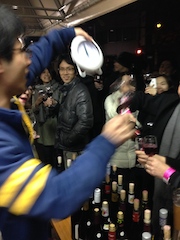
On November 21st, it is the beginning of a banquet on the street. Beaujolai Nouveau is light, so I think I can do my best.
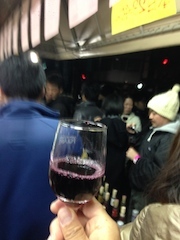
At the event, you can enjoy various kinds of soups and pottery.
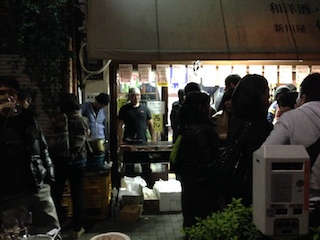
It's like this gathering!
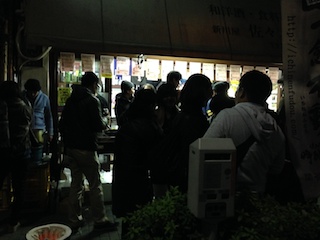
Did you drink everything? I think I drank everything in order.
Some may have gone out.
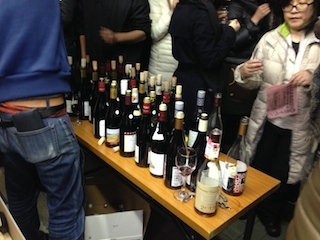
It's like this, and it's open in an hour. It was a rich hour.
I would like to come here again next year.
Shinkawaya Sasaki Shoten seems to have occasional sake events. I'll introduce the website below.
www.sasas.jp
[kimitaku]
January 28, 2014 09:00
This is an introduction of the city walk map.
These six maps are issued by the Chuo-ku Tourism Association, Chuo-ku Shopping Street Federation, and Chuo-ku.
If you pick it up and arrange it, you will be introduced to Chuo-ku with six pieces.
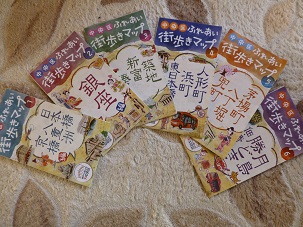
It is made with a gentle color that makes you want to take it in your hand and carry it around.
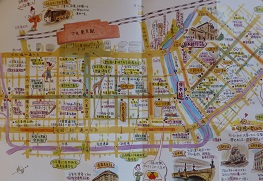
The first one.
This page is located near Nihonbashi Kyobashi from Tokyo Station.
Each of the historic shopping streets is listed, and its main events are also written.
The second one is around Ginza, and the third one is near Tsukiji.
There is also a huge map at the "Platto Tsukiji" information center outside the construction area.
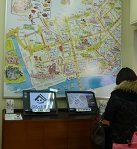 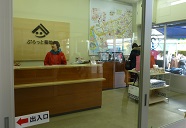
The fourth one is around Ningyocho Hamacho and Higashinihombashi. The fifth one is Hatchobori, Kabuto-cho, and Kayabacho.
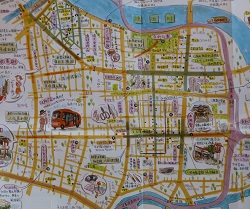 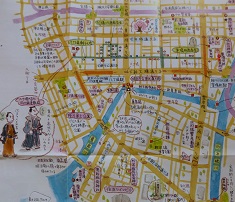
In the shopping streets around Hatchobori, there are many divisions from Edo, and the shopping streets seem to remain the same as the old divisions.
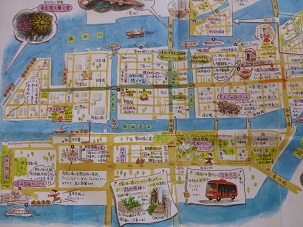
The sixth one is Tsukuda, Kachidoki, Tsukishima and Harumi.
Chuo-ku, which can be seen from this map, is surrounded by many canals and rivers, and seems to be a city of water.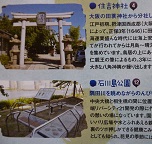
Why don't you take a walk around Chuo-ku with the "Fureai Town Walking Map" in one hand on the day off?
The map seems to be limited. As soon as possible. It is provided for the ward office, branch office, and Chuo-ku Tourism Association.
[Silver]
January 24, 2014 09:00
The “Lunchtime Mini Lecture & Concert” in January this year was held.
Rukabi Yoko Setoyama's "Is that health information okay?" What is health literacy? It was a mini-lecture.
There is a lot of information available in newspapers, magazines, the Internet, etc.
"I wonder  if the information is correct, or simply convey it. if the information is correct, or simply convey it.
The recipient of the information correctly determines whether the information is biased.
It's important to use information smartly! "It was a very useful and kind story.
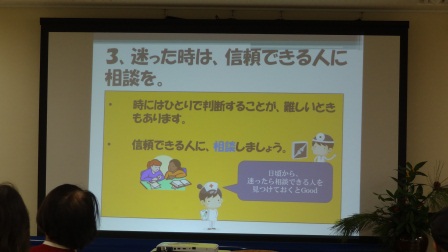
The usage is not too much, and if you have trouble making a decision, consult someone.
See you.
1.Beware of the word "work"!
2.It's not too much!
3.If you are unsure, consult with someone who can consult!
If you have trouble deciding on a medicine or usage, or if you are lost, go to Rakanabi! "
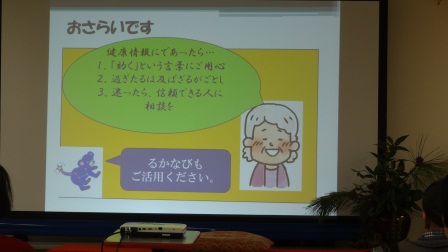
It was a story with fun humor that I would never forget about PR. We recommend that you join us next time. that I would never forget about PR. We recommend that you join us next time.
Click here for the official website. http://rcdnp.slcn.ac.jp/lukanavi/ http://rcdnp.slcn.ac.jp/lukanavi/
By the way, it was a rakugo by Shinji Yamagami, a member of Sanchotei Hanpo (pronouce Sancho Panza). was a rakugo by Shinji Yamagami, a member of Sanchotei Hanpo (pronouce Sancho Panza).
Today's performance is "Odoya Avenge".
The three people who stayed in the inn (three from the beginning) tried to stay on the floor after the fuss.
It was a slapstick-like drama woven by the samurai who stayed with the house and the owner of the inn who heard the loud chatter.
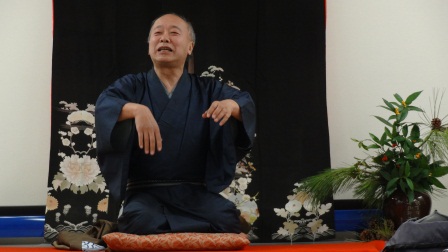
I thought it was a story that made it light and stylish and attracted people, and this was called a story art.
The audience was so enthusiastic about the story in front of the audience with too much enthusiasm.
The details of the story seem to violate intellectual property rights, so I  will omit it, but it was an interesting and fun story anyway. will omit it, but it was an interesting and fun story anyway.
I heard it for the first time, but I became a fan.
In addition, the stage name (the last name part is called the Teigo) is said to be called Sancho Pansa.
He named himself after the name of Sancho Panza in valet of Don Quijote , and he was a humorous man. , and he was a humorous man.
Shinji Yamagami seems to draw pictures, and he is also exhibiting at St. Luke's Gallery.
The next exhibition of the picture will be exhibited for about a week from June 9th. Don't miss it!
[Silver]
January 17, 2014 14:00
This year's Tokyo Marathon 2014 will be held on February 23.
Prior to that, the marathon course was divided into five sessions, from Saturday, January 25 to February 22.
Every Saturday we visit historic sites and shop at the shopping streets of the course.
There is an  event to walk event to walk happily happily  and healthily. Participation fee is free and healthily. Participation fee is free , but you need to apply in advance. , but you need to apply in advance.
The cost of shopping etc. is borne by the individual, but in Chuo-ku edition, you drink amazake and buy puppet ware in Ningyocho.
In Tsukishima, you can eat lunch such as monjayaki, and buy specialty lever fry and long-established Japanese sweets.
Please click here for more information. /archive/2013/02/post-1546.html
/archive/2013/02/post-1553.html
Click here to apply for the event  and flyer. and flyer.
http://tcgc.5.pro.tok2.com/event/Marathon%202014.pdf
[Apricot peony]
January 16, 2014 14:00
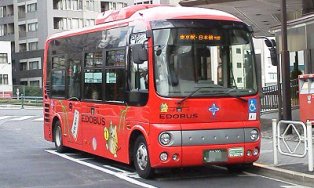 The community bus "Edo Bus" in Chuo-ku is a cute bus with a comical cat. The community bus "Edo Bus" in Chuo-ku is a cute bus with a comical cat.
Starting from the ward office, there are two routes: the north circulation that returns around Tokyo Station, Nihonbashi, and Hamacho, and the south circulation that returns around St. Luke International Hospital, Shinkawa, Tsukuda, Harumi, and Kachidoki. There is.
The fare is 100 yen, and the service is about 1 every 20 minutes.
It is very convenient because it goes to related facilities in the ward, such as the inhabitant of a ward center and senior center, and a place slightly away from the station.
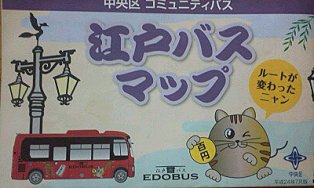
"Edo bus map" which published service route and stop, timetable of this Edo bus is distributed at ward offices, etc., but this is a little Chuo-ku guide.
In addition, the content changes every season, and during the cherry blossom season, the highlights of the cherry blossoms along the line are posted, and the one published in September last year is a stage walk map of movies, dramas, and novels. The Mitsui Main Building in Nihonbashi, which was the location of the headquarters of the Tokyo Central Bank, which appeared in Naoki Hanzawa, was also posted.
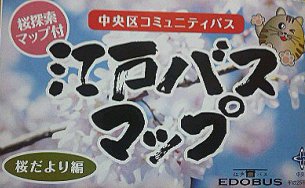 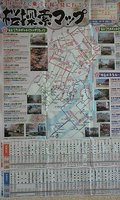
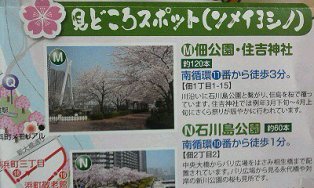 ↑Click it to increase it. ↑Click it to increase it.
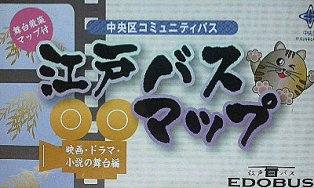 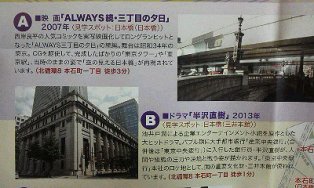
There are many such famous places, so if you purchase a one-day ticket of 300 yen, you can easily visit Chuo-ku.
The season is the coldest time of the year, but how about going around Chuo-ku using the Edo bus instead of just staying at home?
[Tachibana]
January 15, 2014 14:00
Every day, people tend to stay at home due to the cold, but if you take a stroll on a sunny day, how about the Hamacho Ryokudo?
"Hamacho Ryokudo" begins opposite the exit of Hamacho Kiyosubashi in the capital city.
If you dive through an arched tunnel, you will find an almost straight green road sandwiched between roads on both sides.
This is a green road built by reclaiming the place where the Hamacho River (also known as the "Midori River" from the name of the bridge that was built) used to flow.
As you walk north, you will encounter amazake Yokocho, where you will find a statue of Benkei Musashibo, famous for its Kanjin Book (the place where one of the treasure chests of Chuo-ku last year's treasure hunts was located).
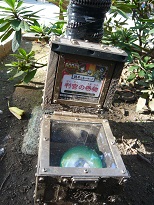
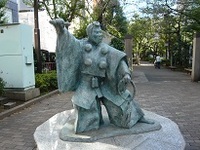
If you go further, there is a monument near the entrance on the north side of the "Place of Rehabilitation of Chinese Medicine".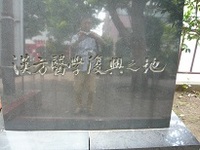
Exit this mouth and pass by the side of the Nihonbashi Fire Station Ningyocho Sub-Branch, and you will come to "Konza-dori" connecting the Hisamatsucho Intersection and Ningyocho Intersection.
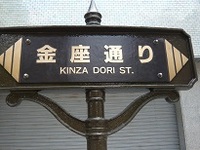 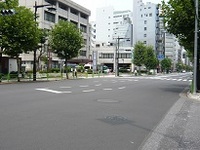
"Koganza-dori" was built to cross the Hamacho River.
And just on the other side of "Konza-dori", there is a monument of "Ogawa Bridge Origin" along with Hisamatsu Police Station.
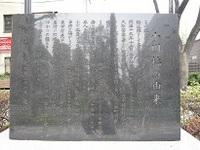
The origin of Ogawa Bridge is that a pistol robbery occurred in Bakurocho in December 1886, and a culprit discovered near Tachibana-cho (currently Higashi-Nihonbashi 3-chome) by Hisamatsu Police Station Ogawa on the way to rushing and seriously injured He was tracked to the banks of Hamacho and caught the man. The criminal had 80 exils, and five were violent criminals killing people.
However, inspector Ogawa (2nd grade advanced due to his arrest) died two years later due to the wound at this time. Therefore, we regretted the precious death of the assistant inspector, named the bridge next to the Hisamatsu Police Station Ogawa Bridge, and decided to leave the immortal achievement for future generations.
I often heard this story from my grandparents born in the Meiji era, but I am a little surprised that there was a violent crime of pistol robbery (although he had even a sword) in Meiji period, but I thought that the bravery of policeman Ogawa who confronted this violent crime alone would have been a great officer for children.
|
Links
|











 The community bus "Edo Bus" in Chuo-ku is a cute bus with a comical cat.
The community bus "Edo Bus" in Chuo-ku is a cute bus with a comical cat.


 ↑Click it to increase it.
↑Click it to increase it.








